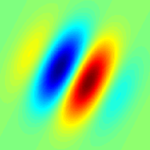مجموعه مقالات فیلتر گابور (Gabor Filter) قسمت 1
1.A GABOR FILTER TEXTURE ANALYSIS APPROACH FOR HISTOPATHOLOGICAL BRAIN TUMOUR SUBTYPE DISCRIMINATION
فایل PDF – در 14 صفحه- نویسنده : Omar Sultan Al-Kadi
A GABOR FILTER TEXTURE ANALYSIS APPROACH FOR HISTOPATHOLOGICAL BRAIN TUMOUR SUBTYPE DISCRIMINATION
پسورد فایل : behsanandish.com
2.A Review Paper on Gabor Filter Algorithm & Its Applications
فایل PDF – در 5 صفحه- نویسنده : Neelu Arora , Mrs. G. Sarvani
A Review Paper on Gabor Filter Algorithm & Its Applications
پسورد فایل : behsanandish.com
3.Comparison of texture features based on Gabor filters
Abstract -The performance of a number of texture feature operators is evaluated. The features are all based on the local spectrum which is obtained by a bank of Gabor filters. The comparison is made using a quantitative method which is based on Fisher’s criterion. It is shown that, in general, the discrimination effectiveness of the features increases with the amount of post-Gabor processing.
فایل PDF – در 6 صفحه- نویسنده : P. Kruizinga, N. Petkov and S.E. Grigorescu
Comparison of texture features based on Gabor filters
پسورد فایل : behsanandish.com
4.Evolutionary Gabor Filter Optimization with Application to Vehicle Detection
Abstract—Despite the considerable amount of research work on the application of Gabor filters in pattern classification, their design and selection have been mostly done on a trial and error basis. Existing techniques are either only suitable for a small number of filters or less problem-oriented. A systematic and general evolutionary Gabor filter optimization (EGFO) approach that yields a more optimal, problem-specific, set of filters is proposed in this study. The EGFO approach unifies filter design with filter selection by integrating Genetic Algorithms (GAs) with an incremental clustering approach. Specifically, filter design is performed using GAs, a global optimization approach that encodes the parameters of the Gabor filters in a chromosome and uses genetic operators to optimize them. Filter selection is performed by grouping together filters having similar characteristics (i.e., similar parameters) using incremental clustering in the parameter space. Each group of filters is represented by a single filter whose parameters correspond to the average parameters of the filters in the group. This step eliminates redundant filters, leading to a compact, optimized set of filters. The average filters are evaluated using an application-oriented fitness criterion based on Support Vector Machines (SVMs). To demonstrate the effectiveness of the proposed framework, we have considered the challenging problem of vehicle detection from gray-scale images. Our experimental results illustrate that the set of Gabor filters, specifically optimized for the problem of vehicle detection, yield better performance than using traditional filter banks.
فایل PDF – در 8 صفحه- نویسنده : Zehang Sun, George Bebis and Ronald Miller
Evolutionary Gabor Filter Optimization with Application to Vehicle Detection
پسورد فایل : behsanandish.com
5.Expression-Invariant Face Recognition via 3D Face Reconstruction Using Gabor Filter Bank from a 2D Single Image
Abstract— In this paper, a novel method for expression- insensitive face recognition is proposed from only a 2D single image in a gallery including any facial expressions. A 3D Generic Elastic Model (3D GEM) is used to reconstruct a 3D model of each human face in the present database using only a single 2D frontal image with/without facial expressions. Then, the rigid parts of the face are extracted from both the texture and reconstructed depth based on 2D facial land-marks. Afterwards, the Gabor filter bank was applied to the extracted rigid-part of the face to extract the feature vectors from both texture and reconstructed depth images. Finally, by combining 2D and 3D feature vectors, the final feature vectors are generated and classified by the Support Vector Machine (SVM). Favorable outcomes were acquired to handle expression changes on the available image database based on the proposed method compared to several state-of-the-arts in expression-insensitive face recognition.
Keywords—Face recognition; 3D shape recovery; Gesture and Behavior Analysis.
فایل PDF – در 6 صفحه- نویسنده : Ali Moeini, Hossein Moeini, Karim Faez
پسورد فایل : behsanandish.com
6.IMAGE RETRIEVAL BASED ON HIERARCHICAL GABOR FILTERS
Content Based Image Retrieval (CBIR) is now a widely investigated issue that aims at allowing users of multimedia information systems to automatically retrieve images coherent with a sample image. A way to achieve this goal is the computation of image features such as the color, texture, shape, and position of objects within images, and the use of those features as query terms. We propose to use Gabor filtration properties in order to find such appropriate features. The article presents multichannel Gabor filtering and a hierarchical image representation. Then a salient (characteristic) point detection algorithm is presented so that texture parameters are computed only in a neighborhood of salient points. We use Gabor texture features as image content descriptors and efficiently emply them to retrieve images.
Keywords: Gabor filters, image retrieval, texture feature extraction, hierarchical representation
فایل PDF – در 10 صفحه- نویسنده : TOMASZ ANDRYSIAK, MICHAŁ CHORA´ S
IMAGE RETRIEVAL BASED ON HIERARCHICAL GABOR FILTERS
پسورد فایل : behsanandish.com
7.Iris Recognition Based On Adaptive Gabor Filter
Abstract. Aiming at the problem of multi-category iris recognition, there proposes a method of iris recognition algorithm based on adaptive Gabor filter. Use DE-PSO to adaptive optimize the Gabor filter parameters. DE-PSO is composed of particle swarm optimization and differential evolution algorithm. Use 16 groups of 2D-Gabor filters with different frequencies and directions to process iris images. According to the direction and frequency of maximum response amplitude, transform iris features into 512-bit binary feature encoding. Calculate the Hamming distance of feature code and compare with the classification threshold, determine iris the type of iris. Experiment on a variety of iris databases with multiple Gabor filter algorithms, the results showed that this algorithm has higher recognition rate, the ROC curve is closer to the coordinate axis and the robustness is better, compare with other Gabor filter algorithm.
Keywords: Iris recognition Gabor filter Particle swarm optimization Differential evolutionFeature encodingHamming distance
فایل PDF – در 8 صفحه- نویسنده : Shuai Liu, Yuanning Liu, Xiaodong Zhu, Guang Huo, Jingwei Cui, and Yihao Chen
Iris Recognition Based On Adaptive Gabor Filter
پسورد فایل : behsanandish.com
8.USE OF GABOR FILTERS FOR TEXTURE CLASSIFICATION OF AIRBORNE IMAGES AND LIDAR DATA
فایل PDF – در 12 صفحه- نویسنده : Urszula Marmol
USE OF GABOR FILTERS FOR TEXTURE CLASSIFICATION OF AIRBORNE IMAGES AND LIDAR DATA
پسورد فایل : behsanandish.com




دیدگاه خود را ثبت کنید
تمایل دارید در گفتگوها شرکت کنید؟در گفتگو ها شرکت کنید.